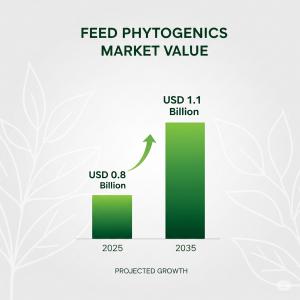Feed Phytogenics Market to Reach USD 1.1 Billion by 2035, Driven by Demand for Natural Feed Additives
Feed phytogenics market is growing as manufacturers seek natural alternatives to antibiotics, with essential oils leading growth in the poultry sector.
NEWARK, DE, UNITED STATES, August 18, 2025 /EINPresswire.com/ -- The feed phytogenics market is expected to grow from USD 0.8 billion in 2025 to an estimated USD 1.1 billion by 2035, a compound annual growth rate (CAGR) of 3.0% driven by the increasing demand for natural and sustainable feed solutions. This growth trajectory offers a clear pathway for manufacturers to address critical industry challenges.
A Solution-Focused Approach for Manufacturers
The demand for feed phytogenics is directly linked to the livestock industry’s urgent need for alternatives to traditional antibiotic growth promoters (AGPs). As consumers increasingly seek antibiotic-free meat, manufacturers have a unique opportunity to provide products that enhance animal health and productivity naturally. Scientific studies have shown that phytogenics, which include herbs, spices, and essential oils, can improve feed efficiency, boost immune response, and reduce gastrointestinal diseases in livestock. By investing in these solutions, manufacturers can position themselves as partners in creating more sustainable and profitable animal protein production.
Poultry farming, in particular, is a major driver of this market, with the segment projected to account for 41.5% of the market revenue in 2025. The industry's rapid production cycles and the global demand for poultry meat and eggs make it a prime area for the integration of phytogenic additives, which can improve gut health and reduce mortality rates. Essential oils are at the forefront of this growth, holding a 36.7% market share in 2025 due to their potent antimicrobial properties and effectiveness in improving digestion.
Navigating Regional and Market Dynamics
While the market's growth is global, key regions are showing unique trends. BRICS economies are outpacing the global average, with China’s market growing at a 4.1% CAGR and India at 3.8%. These markets are benefiting from favorable government policies and increased awareness of feed efficiency. In China, government programs have incentivized phytogenic integration, leading to a significant increase in local manufacturers and feed mills adopting these solutions. Similarly, in India, domestic nutraceutical firms are leveraging native herbs like neem, tulsi, and ashwagandha to meet rising demand from poultry and aquaculture producers.
Within the OECD group, Germany leads with a CAGR of 3.5%, driven by strict AGP regulations and a strong push for sustainable animal production. The United Kingdom and the United States are also seeing steady adoption, with growth rates of 2.9% and 2.6% respectively. In the US, large meat processors are shifting toward clean-label supply chains, with major poultry integrators substituting AGPs with phytogenics in a significant number of their facilities.
Overcoming Challenges with Innovation
Despite the market's positive outlook, challenges remain. The price volatility of botanical raw materials and region-specific usage patterns pose key challenges for consistent supply and product standardization. However, manufacturers are tackling this by optimizing oil blends and delivery systems to maximize effectiveness. This focus on research and development ensures that products are not only effective but also stable and standardized across batches.
Key players are actively shaping the competitive landscape. Global leaders like Cargill, ADM, and DSM are focusing on essential oil and herbal extract-based additives tailored to poultry and swine nutrition. Regional firms, such as Vinayak Ingredients and Ayurvet Limited in India, are leveraging local herbs and cost-effective formats to expand their reach. This diverse ecosystem of players, from global giants to specialized regional companies, ensures a constant stream of innovation and tailored solutions for different markets.
The recent acquisition by Cargill of two US feed mills in September 2024 is a testament to the industry's commitment to expanding production and distribution capabilities to meet growing customer needs.
By focusing on these compelling, natural solutions, manufacturers can effectively address the livestock industry's shift toward sustainability and meet the growing consumer demand for clean-label meat products.
Request Feed Phytogenics Market Draft Report - https://www.futuremarketinsights.com/reports/sample/rep-gb-22651
For more on their methodology and market coverage, visit https://www.futuremarketinsights.com/about-us.
Explore Related Insights
Feed Carbohydrase Market: https://www.futuremarketinsights.com/reports/feed-carbohydrase-market
Feed Enzymes Market: https://www.futuremarketinsights.com/reports/feed-enzymes-market
Feed Attractants Market: https://www.futuremarketinsights.com/reports/feed-attractants-market
Editor’s Note:
This release is based on a market analysis report covering key trends, regional insights, and the competitive landscape of the feed phytogenics market. The provided data focuses on growth drivers and key players.
Rahul Singh
Future Market Insights Inc.
+1 347-918-3531
email us here
Legal Disclaimer:
EIN Presswire provides this news content "as is" without warranty of any kind. We do not accept any responsibility or liability for the accuracy, content, images, videos, licenses, completeness, legality, or reliability of the information contained in this article. If you have any complaints or copyright issues related to this article, kindly contact the author above.

